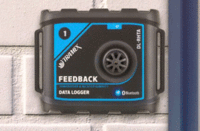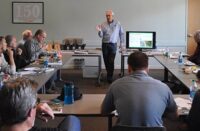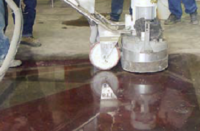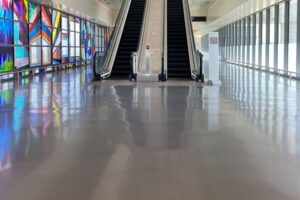Like many of you, I attended this year’s World of Concrete with great anticipation. Half expecting to see more of the same and half hoping to be blown away by something new and exciting. Well, as expected, there are a few new and exciting things out there, but all and all, on the surface, it looks like there are no earth-shattering changes on the horizon for decorative concrete.
I say “on the surface,” because I think we all feel it coming. Something big, something revolutionary. We just haven’t been able to pinpoint it yet. Let’s dive a little deeper.
Technology is on a fast track
Technology is advancing at a level we couldn’t have imagined a decade ago. Is everything going virtual? Are we all going to soon be replaced by concrete printing robots? Maybe … but I don’t think that’s the change we all feel. Talking to my many friends in the industry the past few months, they all seem to be grasping at it, but not quite touching it. But it seems to be pretty raw.
Yes, the world around us is changing at a fast pace. If you’re online at all and part of any concrete Facebook group, the exchange of ideas (and opinions) is coming at us in all directions whether we are expecting it or looking for it or not. So, many people assume the next big thing for our industry is technology.
Let’s put everything online and do away with traditional means and methods. The wave of the future and the next generation of our workforce wants that, right? I don’t think so.
Let me ask you this, why are you reading this magazine? Is it so you can surf the web or post your opinion online about something you read here? If you’re like me — and many of the readers — I think that’s far from the truth.
The reason we read Concrete Decor is because we find inspiration from other industry professionals, and we like the tangible element the magazine offers. The tangible element … isn’t that why we all like working with concrete?
Concrete is something tangible we can touch, see and smell. That’s why we like print magazines, too. We can see and feel the paper in front of us. It makes it feel more real than something we scroll past in a newsfeed.

Technology has created so much noise out there that much is lost. I think the next big thing for our industry is the tangible element. Yes, technology can be used to promote these tangible elements, and even connect more and more to them. But the next big thing for us is to communicate in a tangible way. Is this new? No. It’s taking old technologies and adapting them to today’s world.
Just like stamped concrete. We don’t see anyone spinning around in the old Bowman hamster wheel anymore to stamp concrete, but we see the technology that Brad Bowman invented back then in today’s innovations of stamps and stencils. Innovation is about transforming the great ideas from the past and evolving them with today’s ideas and technologies.

Concrete and its possibilities
I’m so impressed and shaped by the technologies and advances within our industry. I feel like I’ve grown up with the evolution of decorative concrete. When I was a small child, stamped, formed and vertically carved concrete was innovative. With those leaps and bounds creating the foundation for our industry of “decorative concrete,” the industry grew right before our eyes.
Now, any one of us can go to a local supplier and rent a stamp or buy a vertical mix right off the shelf. Yesterday’s innovations have become today’s respected commodities. One of the things that makes our industry great right now are the intangibles: our relationships, our knowledge and the dreams of what concrete can be.
On a monthly basis, I give the American Society of Concrete Contractors’ Decorative Concrete Council presentation on decorative concrete trends to architects. And during those presentations, I always ask the audience what they see as a current trend.
At the end of one of these recent talks, one of the principals said, “Karen, I’ve attended several of your presentations and I always leave inspired with new ideas and excitement for decorative concrete.” That’s the fire we want to light in the design industry.
Imagine if we all talk to the design community about what could be possible with decorative concrete. It’s our job as decorative concrete professionals to equip architects and landscape architects with tangible elements, so they understand what is possible and push the envelope with us.
Imagine if at the next Concrete Decor Show, Decorative Concrete LIVE! or World of Concrete, there were a multitude of architects and landscape architects walking around with their notebooks eagerly taking notes and sketching up new ideas. It can happen in their board rooms when we go to them. I don’t see it too far-fetched for them to get as amped up about these shows as the rest of us.
Turning dreams into reality
When I first started The Art of Concrete about a year and a half ago, I met with a small group of landscape architects with very little to offer except my knowledge and excitement. But, because I had known them for a while, they knew my passion and came prepared to the meeting with live projects and questions.
I helped them with a few projects that day, telling them what materials, colors and finishes made the most sense for each application. We scanned scores of Pinterest pages and material suppliers’ websites — gathering ideas and figuring out on paper how to turn them into reality.
My crew is currently wrapping up one of those projects we dreamed about together. Instead of a traditional grouted boulder or sculpted concrete drop structure, the landscape architects wanted something more interesting — yet just as functional — for the surrounding community.
Honestly, they had most of it figured out without me, but I told them what was truly possible. We ended up pouring the flatwork in several steps or platforms. Each platform had several different finishes of concrete along with channels for water to flow. This project will look interesting when dry and when water’s flowing over it.
The landscape designer also created areas for people to walk over the elements. I’m excited to see this project being built because it shows how a little bit of collaboration can produce and advance decorative concrete expectations. We don’t have to be limited by what’s been done in the past. Instead we can build upon it.
Help spread the word
Tangible elements are what are next for our industry, and the exciting fast-paced world of technology will help us get there. Within minutes, I can collaborate with contractors and architects in different states dreaming up the next exciting project. Technology is linking us all, and the design industry is expecting us to bridge together to make their dreams a tangible reality — wherever we are.
What I love about our industry now is the lack of borders. We are much more collaborative than we ever have been before, and that’s where new ideas and innovations are going to come from. We have more resources and opportunities to learn something new from events like the Concrete Decor Show and industry fairs.
We are also an extremely passionate group compared to most other building trades. It’s easy to get excited about concrete and its possibilities, and to pass that fire onto the design community.
Because of this drive for tangible elements, I encourage everyone to write more and present more. Being in front of each other and the design community will help our industry explode with new ideas. Seek out landscape architects and architects and don’t just talk to them. Show them what you can do in pictures and samples.
You’ll get invigorated by their excitement and ideas, and they’ll probably convince you to try something slightly new. Combining old techniques with new ideas will continue to push our industry to new heights.















